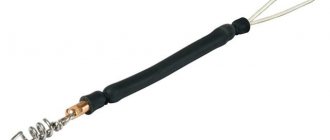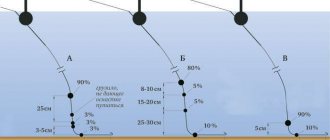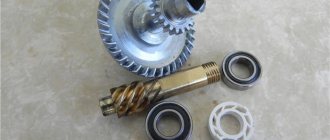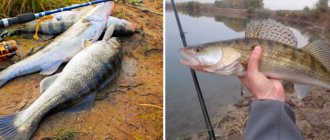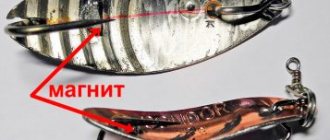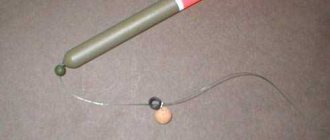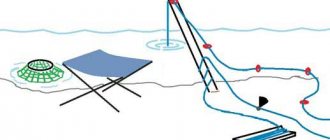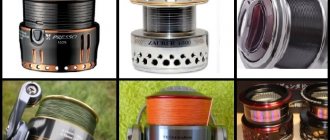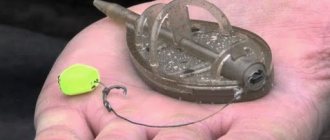Pros and cons of using feedergam
The constant use of a high-quality device is very important when feeder fishing on thin equipment, where you need to attach small hooks numbered 6–8 to a delicate feeder leash. Experienced fishermen claim that the smaller the equipment parts, the more invisible they are to suspicious fish.
To prevent breaks during intense bites, you should use an elastic band, which acts as a lead shock absorber, reduces the load on the braid and protects it from breaking when hooking large trophies.
Fidergam has the following advantages:
- simplifies fishing by absorbing its sharp bites;
- keeps the equipment intact;
- allows the use of thin leashes;
- used in different types of installation;
- helps make casts over longer distances;
- shows excellent shock-absorbing properties when successfully catching large trophies.
But along with the advantages, rubber also has a disadvantage: bites from small fish are less noticeable. This is due to the stretching property of the device.
The use of feedergam has a negative impact on long-term fishing of some types of fish, because when stretched, the product allows the prey to perform additional actions to free itself.
Many fishermen claim that when using the product, it is quite difficult to bring a large trophy into the fish tank. One of the disadvantages of feedergam is the unreliability of node connections, the quality of which must be constantly checked.
Federgam: why is it needed?
Simple rubber is unreliable due to low elasticity and elasticity. Fidergam, in its properties, is an improved version of the usual fishing elastic.
Read: Fishing with an elastic band
Feeder rubber contains latex and silicone - components that increase the strength of the material. Feedergam helps reduce the load on the line, which reduces the risk of line breakage when catching large fish. This is the main advantage of using feeder rubber.
Fidegram installation is carried out in several stages. Beginner fishermen may have a number of difficulties with gartering, so before you go fishing with new gear, practice tying the correct knots.
Fidegram is useful for people who decide to catch bream, pike or other large and medium-sized fish. Plug rubber strengthens the fishing line and significantly increases its strength. With a fidegram, you don’t have to worry about whether the fishing line will withstand the heavy weight of the trophy when hooking.
Feedergam is an additional insurance for fishing rod and line when fishing, it increases the maximum weight that the line can withstand.
Installation with feedergam
Nowadays, many fishermen use feeders in the feeder assembly of most equipment. The most popular of them are in-line, asymmetrical loop and fastening with a special tube - an anti-twist.
Sliding equipment
The most common option is considered to be a sliding rig, which not only protects the leash, but also prevents the feeder from being shot off while casting over a considerable distance. To tie it, you should prepare a piece of elastic about 25 cm long.
The feeder rubber is attached to the main braid. In order to attach the shock absorber to the braided cord, you need to use a swivel, because connecting the braid directly to the feedergum can lead to cutting it.
Then a stopper is successively put on the product, limiting the movement of the feeder, a feeder, the next stopper and a swivel, to which a thin leash with a hook is attached.
Due to the fact that the units can slide, experienced fishermen advise protecting the shock absorber mounting area with two cambrics.
Asymmetrical loop
Many feeder fishing enthusiasts constantly use an asymmetrical loop, because this element of equipment is superior in sensitivity to other methods of installing feeder rubber. But for its high-quality work, you need to know its main features.
To properly attach a shock-absorbing feeder when traveling, you should perform the following steps:
- Take 60 cm of monofilament with a diameter of 0.25 mm, fold it in half and knit a small loop at the tip.
- Then a twist is made from two pieces of monofilament 10 cm long, and a carabiner is attached to its end.
- A 13 cm loop is measured on the monofilament and a stop knot is tied.
- A few centimeters from the knot, you need to tie a loop to which the main fishing line will be attached.
Anti-twist
The anti-twist device with outlet from the feeder is equipped using a small curved plastic tube and a carabiner to which the feeder is attached to the feeder.
The length of the anti-twist can be in the range of 5–15 cm and the fishing line must pass freely inside it.
This device prevents the rig from twisting during long casts, and its ease of assembly makes it popular among fishermen during installation. But the anti-twist slightly reduces the maximum casting distance, but this is better than tangled gear.
Paternoster with feedergam
This type of installation involves placing the feeder on a small piece of monofilament 15 cm long. The paternoster for the feeder has proven itself well when fishing on a clay bottom. In such places, the bait may get stuck, but the hook with bait will remain above the surface of the bottom and the prey will notice it.
In this rig, high-quality feeder rubber is the connecting element between the leash and the braid. The larger the insert is used, the smoother the bites will be felt, but the prey will become much more difficult to hook.
To equip your fishing rod with a paternoster yourself, you will need the following parts:
- swivel;
- a small piece of feedergam;
- monofil;
- feeder
The feedergum is attached to the braid using the usual “loop-to-loop” method. Then one end of the shock absorber is connected to the leash, and the other to the feeder. The length of the leash will be about 45 cm. In this case, you can tie a large hook, but this method of fastening is called a modernized paternoster.
Do I need a feeder with monofilament?
When using monofilament instead of braided cord, a shock absorber on the feeder is not needed. Because of it, the tensile strength of the tackle will greatly increase, which will lead to the loss of sluggish bites and frequent disappearances of the long-awaited prey.
Experts have found that the elongation of 10 cm of feedergam is equivalent to 10 m of ordinary fishing line.
The product is necessary when fishing for large predators, because it allows you to significantly improve the quality of the gear, use thin equipment and increases the catch. When fishing for small fish and when using monofilament, you should not hook the feeder.
What is the point of using feeder rubber?
The purpose of feeder rubber is to increase catch. This equipment is good for sport fishing, where according to the rules it is forbidden to use gear that can cause injury to fish, and for ordinary household fishing, such as carp. Thin leashes go well with the feedergam.
Thin fishing line is easier to thread somewhere and costs less. However, if you are fishing for large fish, the line may break. Therefore, you may need a thicker line and landing net after removing it from the water.
Feeder rubber softens the jerks of large and medium-sized individuals: weighing from two to five kilograms. Rubber reduces the force of their jerk, which prevents the prey from falling off prematurely. The equipment is good for catching carp or grass carp in paid closed reservoirs.
Of course, monofilament, a no less popular product among fishermen, is suitable for shock absorption. However, what is the advantage of feedergam over monofilament? Where we would need 10 meters of monofilament, we only need 10 centimeters of feedergam.
Feedergam is also actively used when fishing with braided lines. The material is quite durable, but at the same time inextensible. The risk that the line will break under the weight of the trophy is especially high. In this case, feedergam serves as additional protection.
Since the feedergam entered world markets, only isolated cases of production disruption have been noted. It is extremely difficult for fish to break off from dense, elastic rubber, since the resistance force of the leash in this case will increase many times over.
Using feedergam in feeder equipment
Feeder rubber can last quite a long time. Without a feeder, the main load from the weight of large prey falls directly on the fishing rod.
This is unsafe, because in the event of a strong jerk, the individual can drag the tackle with it or even break the rod. The feeder serves as a regulator that distributes pressure on the gear. Let's say you use an elastic band that is only 3 centimeters long. But this will already be enough to compensate for the load on the fishing line and fishing rod when the fish vigorously shakes its head. However, it is worth keeping in mind the fact that a feeder with a length of 15 centimeters or more has less information about the bite.
The line's sensitivity to bite decreases. It may turn out that when catching small fish, the float does not twitch at all. Therefore, try not to overdo it when connecting the feedergam. 5-10 centimeters is a good option for catching small and medium prey.
A segment of this length is suitable for fishing in a reservoir where fish of different sizes are found. But if you are going to catch pike or silver carp, then you can use a long feeder, since a large specimen puts a large load on the gear.
In fact, feedergam is a universal equipment. You can easily use it in a situation where, for example, you planned to catch small fish, but admit the presence of larger ones. In this case, the leash is attached using an asymmetrical loop.
A leash with a hook is simply attached to a short piece of rubber. This is necessary when fishing on a muddy bottom, or when the fishing rod has a thin line.
Flaws
Feedergam has advantages and disadvantages. Among the disadvantages:
- The elastic band will cause some inconvenience for beginners using such gear for the first time;
- In order to properly secure it, you will need some additional elements;
- Not very suitable for fishing in running water - a river, a lake, since the leash can get tangled when throwing the gear;
Read: Making an anti-twist for donkey - If the equipment catches the feeder, you will have to re-mount the entire equipment.
Therefore, before you go fishing, it is better to secure the rubber at home. Over time, you will get used to it, it will be much easier for you to cope with securing the feeder. But first, try to secure everything before going ashore.
Advantages
In addition to the disadvantages, feedergam rubber also has advantages appreciated by fishermen all over the world. This type of gear is the most durable and reliable. Point by point, we can highlight the following advantages characteristic of elastic bands of this modification:
- The high elasticity of the rubber provides the possibility of self-cutting installation, the effectiveness of bites will increase significantly. With a certain gravity, it will be possible to pull out large prey;
- The rubber band is very sensitive. You will see a signal even if the fish resists less actively after biting;
- The equipment is perfect for muddy ponds. Best for ponds or lakes with weak currents. These are where silver carp, large freshwater species, are found;
- Excellent for “spot” fishing in certain places. The hook and line can be carried away by choppy water. Feeder rubber also serves as a weighting agent and fixation for the fishing line;
- This type of tackle injures the fish less. Suitable if you need to check an individual for the presence of diseases if the reservoir is in an area of chemical contamination. With feedergam it is easier to fish according to the “catch and release” principle. Suitable for ichthyologists or fishery owners;
- Increases the range, smoothness, and accuracy of casting a hook while fishing;
- You can use leashes of any length, including thin ones designed for catching roach and other small fish.
It is not surprising that this equipment is the only one allowed in sport fishing competitions, since the goal of the participants is to catch as many fish as possible without injuring them. The manufacturing technology fits well into the regulations of sport fishing, allowing to minimize the breaking of the hook or the “missing” of the bite by the participant.
How to choose the right feeder tires
In fishing stores you can choose shock absorbers of a variety of colors, which are designed for any fishing conditions. But the rubber must match the color of the water in the pond. When fishing on muddy bottoms, black, transparent or swampy jigs are ideal because bright feeders will only scare off potential prey.
The product should be selected for a specific leash. The breaking load of the product should be slightly greater than that of a monofilament product. But you don’t need to overdo it, because a hard feeder greatly reduces the sensitivity of the fishing rod.
In other words, if the elastic test is too large, then when a large fish bites, it will stretch very much and allow the prey to perform additional actions to free itself.
The longer the rubber shock absorber is made, the lower the breaking load of the monofilament line will be. For this reason, the size of the insert should be limited only by the length of the leash in order to be as invisible as possible in the water.
Option for tying feedergam (twisting)
In this case, we will get a twist. To do this, take a piece of feedergam and begin to twist it in different directions, resulting in an even twist of rubber.
To secure the twist from untying, we make a figure eight knot at the end. When tightening, the knot does not need to be wetted. If you use a feeder with a thickness of 0.8 mm or less, we recommend making a twist of no more than 6 cm, otherwise it will be more difficult to detect the fish when hooking.
The point of such a twist is that when biting and hooking, it will not stretch, leaving the tackle as sensitive as possible, but during jerks of a large fish, the rubber will begin to depreciate, protecting the thin leash from breaking. The elastic band is attached to the rig itself with a figure eight knot or a loop in a loop, and to the leash with a noose. See this video clearly.
We recommend that you familiarize yourself with: types of fishing knots
The most popular manufacturers of feeder gum
The most common models of modern feeder shock absorbers are considered to be products from the British and Belgian corporation “Browning”. These manufacturers have long been trusted by consumers, so the cost of their goods is quite high. The feeder rubber from these companies is of good quality and meets all environmental standards.
Having carefully studied the products of these companies, experts came to the following conclusions:
- the diameter of the feeder is much thicker than its other analogues;
- Drennan products have a variety of colors, so they can be used in feeder fishing in domestic reservoirs;
- the most compact and high-quality knots are made from Drennan rubber bands;
- In terms of functionality, feeders from both manufacturers are on the same level.
Such conclusions merely reflect the personal opinions of some experts. For this reason, fishermen should buy plug rubber based on personal experience, their own preferences and financial capabilities.
Feeder installation
It is difficult to attach rubber: the strength and fixation of the knots should be constantly checked, they tend to come undone. Typically, a reliable “loop-to-loop” method is used to install a feeder:
- Stoppers are hung on both sides of the 15 cm feeder gum.
- Do a double figure eight.
- One end of the rubber is attached to the fishing line.
- A leash and a hook are attached to the second section of the feeder.
One of the stoppers should slide to ensure the mobility of the feeder.
Loop rigs using Feeder Gum
Feeder rubber is actively used in such equipment as paternoster (Gardner loop), asymmetric and symmetric loop.
In these rigs, Feeder Gum is the connecting link between the leader and the rig.
In order to avoid tangling of the gear when fishing with a paternoster, the length of the fishing line together with the feeder should be 5 cm greater than the outlet for the feeder. Read about how to properly install these accessories here
Inline
When using Feeder Gum on an inline rig (running feeder), the sensitivity of the tackle increases and the likelihood of the feeder being shot off when casting decreases, especially if you are fishing with heavy 100-120 gram feeders.
In this installation, the feedergam is used as the basis. We take a piece 30-40 cm long, thread a swivel with a clasp into it (our feeder will be attached to it), then we thread stoppers on both sides, ideally one should have a clamp; this will give us the opportunity to adjust the sliding length of the feeder. Then we knit figure eight knots at both ends. In order for the tackle to twist less, the connection of the feedergum with the main fishing line must be done through a swivel, which is threaded through an elastic band, before we start tying our knots. A leash made of monofilament, connected to our elastic band, with the help of fastening, loop to loop.
How to choose a feeder?
In order for tackle with feedergam to produce results, it is important to choose it correctly. The rigidity should be selected only for your fishing conditions, your fishing line and hook, which are needed in these conditions. There is no ideal option.
A very soft feeder on a thick hook will not allow you to hook a fish, because if the hook is not sharp enough, the fish will simply pull and spit out the bait. On a hard one, on the contrary, a thin hook will cut out the fish. Therefore, you need to experiment.
The softer the feeder, the thinner the hook and thinner line can be used. For large fish, the feeder must still be rigid, otherwise it is simply very difficult to control the tackle, especially when landing fish.
The diameter of the rubber for the leash should be such that its strength (breaking load) exceeds the strength of the leash by 50-80%.
When buying feeder rubber, it is better not to go for cheapness, but to purchase feeder rubber from trusted manufacturers such as Drennan and Browning. Their price is a little higher, but there are no complaints about the quality and there cannot be any. Feeder rubber consumption is not high at all, so you won’t be able to save much when choosing cheap analogues, and the likelihood of being left without a trophy due to low-quality feeder rubber is very high.
Disadvantages of feedergam
Despite the numerous advantages that the feeder receives by adding feeders to the equipment, there are also many disadvantages. The most important among them:
- reduction of installation sensitivity. First of all, this applies to bites from small fish;
- problems with fishing. Feedergam significantly increases the degree of freedom of the fish that pecked. Thanks to the new possibility of additional maneuver, it is difficult to get the fish into the landing net;
- complication of manufacturing installation;
- With a long feeder it is difficult to hook fish.
Benefits of feedergam
By equipping the installation with feedergam, the fisherman receives a number of undeniable advantages, namely:
- The catchability of the equipment is increased due to the use of delicate fishing line and hooks. At the same time, the feeder rubber protects the tackle from tearing. As a result, the number of bites increases and the number of fish caught decreases;
- the casting range increases, which also becomes smoother;
- the likelihood of the feeder being shot is reduced;
- Feeder rubber, due to its resistance to abrasive influences, is suitable for fishing on shell rock.
What types of feeders are there?
Feeders are divided by diameter, tensile strength and color. The diameter varies from 0.5 mm to 1 mm. A 1 mm thick elastic band can have a breaking force of 14 lb. This breaking load allows the feeder to be used in any reservoir to catch fish of almost any size.
Feedergams are also distinguished by their elasticity coefficient, which shows how much the feedergam will elongate before breaking. Each manufacturer has its own rigidity.
Feeder rubbers are sold in various color variations, thanks to this it is possible to choose the optimal feeder rubber by color depending on the color of the bottom. In addition, feeders can be colorless, transparent and translucent.
What is feedergam?
Why do you need a feeder? Its main purpose is to absorb the jerks of strong fish when playing. In addition, the use of innovative material makes it possible to reduce the thickness of the leaders, which ultimately reduces the fear of fish when approaching the equipment, thereby increasing the success of fishing in general. Some anglers note that rubber can reduce the number of shots of feeders when casting, increasing their smoothness.
They began to use shock-absorbing rubber in feeder installations quite a long time ago, but aircraft model and similar types did not suit feeder operators for many reasons:
- low strength;
- large thickness;
- inconvenience in installing equipment;
- poor protection from atmospheric influences;
- low durability.
Feedergam, which came to the aid of fishermen in 2006, solved these problems and now fishermen have a material that has high strength and security even with a small diameter.
Fidergam is an improved rubber made in the form of a composite from modern materials: latex and silicone. This combination made it possible to create a material with the following characteristics:
- high sensitivity due to low extensibility;
- elasticity and resilience;
- strength: for example, the breaking load of rubber 1 millimeter thick can reach 14 lb;
- durability;
- wide range of colors;
- ease of installation to fishing line or braid on feeder equipment.
